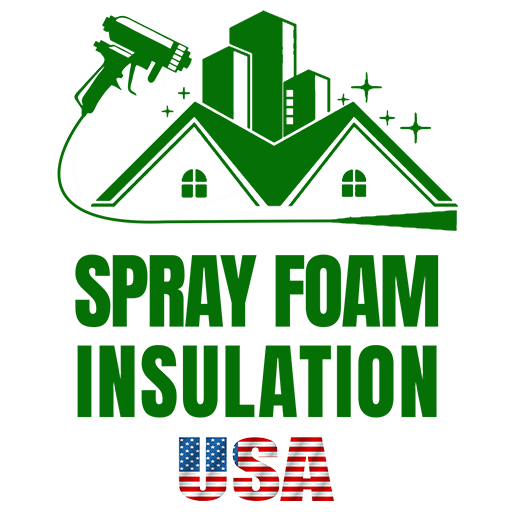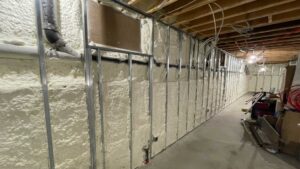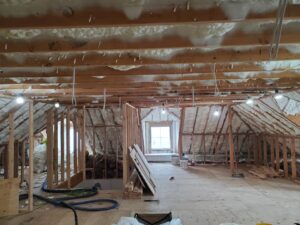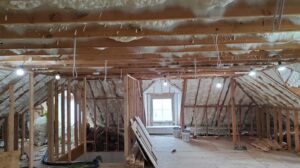DIY Spray Foam Insulation: Quick Guide
- Safety First: Wear protective gear – goggles, gloves, respirator.
- Equipment Needed: Buy or rent a professional-grade spray foam insulation kit.
- Preparation: Clean and dry the area. Mask off areas you don’t want foam on.
- Application: Follow the kit’s instructions. Spray evenly, allow for expansion.
Installing spray foam insulation by yourself might seem daunting, but it’s a powerful way to upgrade your home or business for energy savings and comfort. This beginner’s guide focuses on the essentials: achieving those goals while handling the material safely and efficiently.
Spray foam insulation is a standout choice for NY and NJ property owners looking to cut down on energy bills and enjoy a more consistently comfortable environment indoors. It’s not just about keeping warm in winter or cool in summer; it’s about making your space more energy-efficient and eco-friendly. With the right approach, DIY spray foam installation can be a satisfying project that pays dividends in comfort and cost savings.
This introduction sets the stage for a deeper dive into understanding spray foam types, preparing for installation, the actual application process, and more. We’ll also cover common pitfalls and how to avoid them, ensuring your DIY project is successful and safe. The journey to a more insulated and energy-efficient home starts here.

Understanding Spray Foam Insulation
When it comes to DIY spray foam insulation, knowing your options and their benefits is crucial. Let’s dive into the types of spray foam, explore their advantages, understand R-Value, and compare open cell vs closed cell foam.
Types of Spray Foam Insulation
There are mainly two types:
- Open Cell Foam: It’s lighter and more flexible, making it excellent for soundproofing. It has a lower R-value per inch but is effective for interior applications where moisture control isn’t a primary concern.
- Closed Cell Foam: Denser and more rigid, this type offers higher R-value per inch, making it ideal for both insulation and moisture control. It’s suitable for exterior and interior applications, providing structural reinforcement as well.
Benefits of Spray Foam Insulation
- Energy Efficiency: By sealing gaps and preventing air leakage, spray foam insulation significantly reduces energy bills.
- Comfort: It helps maintain consistent indoor temperatures, enhancing comfort.
- Moisture Barrier: Closed cell foam acts as an effective vapor barrier, reducing the risk of mold and mildew.
- Noise Reduction: Open cell foam is great for soundproofing, making your home quieter.
Understanding R-Value
The R-Value measures insulation’s ability to resist heat flow. The higher the R-value, the better the material insulates. Spray foam insulation generally offers a high R-value, meaning it’s very effective at keeping heat in during winter and out during summer.
Open Cell vs Closed Cell Foam
Choosing between open cell and closed cell foam depends on your specific needs:
- Open Cell Foam is best for indoor applications where sound reduction is important. It allows for moisture permeability, so it’s not recommended for areas prone to water leaks.
- Closed Cell Foam is the go-to for areas requiring high moisture resistance and structural support. It’s suitable for both indoor and outdoor applications.
In conclusion, understanding the types of spray foam insulation and their respective benefits is key to a successful DIY project. Whether you’re aiming for energy efficiency, moisture control, or noise reduction, there’s a spray foam solution that fits your needs. The right choice between open cell and closed cell foam will depend on your specific insulation goals and the area you’re insulating. With this knowledge, you’re well on your way to enhancing your home’s comfort and energy efficiency.
We’ll delve into how to prepare for the installation of your chosen spray foam insulation, ensuring you’re equipped with the necessary safety gear and knowledge to start your DIY project on the right foot.
Preparing for Installation
Congratulations on taking a significant step towards improving your home’s energy efficiency and comfort with DIY spray foam insulation. Before diving into the installation process, it’s crucial to prepare adequately to ensure a smooth, safe, and effective application. This section will guide you through the essential steps of preparation, including safety gear, area preparation, and equipment setup.
Safety Gear
First and foremost, your safety is paramount. Spray foam insulation involves chemicals that can be harmful if not handled correctly. Here’s a list of safety gear you’ll need:
- Respirator: Protects your lungs from airborne particles and chemical vapors. Ensure it’s NIOSH approved.
- Coverall Suit: A disposable suit with a hood will protect your skin and clothing from spray foam.
- Safety Goggles: To shield your eyes from harmful chemicals and flying particles.
- Gloves: Nitrile gloves are recommended for their chemical resistance and durability.
Personal protective equipment (PPE) is not just a recommendation; it’s a necessity for your health and safety during the installation process.
Area Preparation
Proper area preparation is key to a successful and clean installation:
- Clear the Space: Remove any furniture, decorations, or movable objects from the area to prevent them from getting coated in foam.
- Cover and Protect: Use plastic sheeting to cover the floor and any immovable objects. Secure the sheeting with painter’s tape to keep it in place.
- Ventilate: Ensure the area is well-ventilated to disperse fumes. Open windows and use fans if available.
- Mark the Area: Clearly mark the areas where insulation is to be applied. This helps in achieving an even and consistent application.
Equipment Setup
Having the right equipment ready and knowing how to use it is crucial:
- DIY Spray Foam Kit: Ensure you have the correct kit for your project. Kits typically include two chemical component canisters, hoses, and a spray gun.
- Test the Equipment: Before starting, test your spray gun and hoses on a piece of cardboard to get a feel for the spray pattern and flow.
- Check the Temperature: Both the room and the foam insulation should be at the optimal temperature recommended by the manufacturer for best results.
By following these preparation steps, you’re setting yourself up for a successful DIY spray foam insulation project. Taking the time to prepare thoroughly will not only make the installation process smoother but also safer and more effective. Now that you’re prepared, let’s move on to the step-by-step installation process.
Step-by-Step Installation Process
Congratulations on making it this far! You’re now ready to dive into the heart of DIY spray foam insulation. Let’s break down the installation into simple, easy-to-follow steps.
Mixing Foam
First things first, you’ll need to get your foam ready for application. Most DIY kits come with two components that need to be mixed. Here’s how to do it:
- Shake the Canisters: Before mixing, give each canister a good shake. This ensures the chemicals inside are well blended.
- Attach the Hoses: Your kit should come with hoses that attach to the canisters. Make sure they’re secured tightly to avoid leaks.
- Test Spray: Do a small test spray onto a piece of cardboard. This is to ensure the mixture is correct and ready for application.
Spraying Techniques
Spraying the foam correctly is crucial for a uniform and effective insulation layer. Keep these tips in mind:
- Keep the Gun Moving: Move the spray gun in a smooth, continuous motion to avoid uneven thickness.
- Apply Thin Layers: It’s better to apply multiple thin layers than one thick layer. After spraying, the foam will expand to fill the gaps.
- Maintain Distance: Hold the gun about 18 to 24 inches away from the surface for optimal coverage.
Thickness
The thickness of the foam depends on where you’re applying it and the R-value you’re aiming to achieve. As a general rule:
- Walls: Aim for a thickness of about 3 inches for closed cell foam, which gives you an R-value of around 21.
- Ceilings and Attics: You might go thicker in these areas, up to 6 inches, to ensure a higher R-value for better energy efficiency.
Coverage
Understanding how much area you can cover with your kit is essential. Coverage depends on the thickness of the application and the type of foam (open cell vs closed cell). Here’s a simple way to calculate:
- Calculate the Area: Measure the length and width of the space you’re insulating in feet and multiply to get the square footage.
- Refer to the Kit’s Coverage: Each kit should state how many board feet it covers. A board foot is a square foot with 1 inch of thickness.
- Plan for Overlap: It’s wise to buy a little more than you think you’ll need to account for overlap and waste.
By following these steps, you’re well on your way to successfully installing DIY spray foam insulation. Patience and attention to detail are your best friends in this process. Take your time, and you’ll be rewarded with a well-insulated space that saves energy and money in the long run.
Next, we’ll dive into the common mistakes people make with DIY spray foam insulation and how you can avoid them to ensure a smooth and efficient installation.
Common Mistakes and How to Avoid Them
When embarking on the journey of DIY spray foam insulation, it’s easy to get tripped up by a few common pitfalls. But don’t worry, I’m here to guide you through these rough patches. Let’s ensure your project is smooth sailing from start to finish.
Incorrect Mixing
One of the first hurdles is incorrect mixing. The magic of spray foam comes from the perfect blend of its components. If mixed incorrectly, it won’t expand or adhere properly, rendering it ineffective.
How to Avoid:
– Follow the manufacturer’s instructions to the letter. Each kit can have slightly different requirements.
– Practice makes perfect. Try mixing a small amount first to get the hang of it before committing to larger areas.
Over/Under Application
Another common issue is over or under applying the foam. Too much, and you’re wasting material (and money). Too little, and you won’t get the insulation benefits you’re after.
How to Avoid:
– Measure twice, spray once. Calculate the area you’re insulating carefully to estimate how much foam you’ll need.
– Apply in layers. Start with a thin layer, let it expand, and then decide if you need more. It’s easier to add than to remove excess.
Ignoring Safety Measures
This is a big one. Ignoring safety measures can lead to not just a botched insulation job but also serious health risks. The chemicals involved in spray foam insulation can be harmful if not handled correctly.
How to Avoid:
– Wear the right gear. This includes gloves, goggles, a mask, and full-body coverage.
– Ensure good ventilation. Open windows or use fans to keep the air moving and prevent chemical build-up.
A Personal Insight:
A DIY enthusiast once shared, “I thought I could skip the safety gear – big mistake. The irritation was immediate. Never underestimate the importance of protective equipment.”
In Summary
Avoiding these common mistakes comes down to preparation, patience, and respect for the process and materials. Take your time to understand the diy spray foam insulation kit you’re using, measure and plan your application carefully, and always prioritize safety. With these precautions in mind, you’re well on your way to a successful insulation project that will enhance your home’s energy efficiency and comfort.
Now, let’s move on to some of the most frequently asked questions about DIY spray foam insulation to clear up any lingering doubts.
Frequently Asked Questions about DIY Spray Foam Insulation
Can I spray foam insulate myself?
Yes, you can! Many homeowners successfully tackle diy spray foam insulation projects. It requires a bit of preparation and understanding of how the process works. Safety first – wear protective gear and follow the instructions closely. If you’re up for a bit of a challenge and ready to follow step-by-step guidelines, DIY spray foam insulation is within reach.
Is there a downside to spray foam insulation?
While spray foam insulation offers numerous benefits such as high energy efficiency and air sealing capabilities, there are a few considerations to keep in mind. First, the upfront cost can be higher than traditional insulation materials. However, the long-term savings on energy bills often outweigh this initial investment.
Second, incorrect application can lead to issues. For instance, not allowing the foam to expand fully or uneven application can result in gaps or poor insulation performance. That’s why it’s crucial to follow instructions meticulously and understand the product you’re working with.
Lastly, the process involves chemicals, so proper ventilation, protective gear, and adherence to safety guidelines are non-negotiable to protect your health and the quality of your indoor air.
How thick should spray foam insulation be?
The thickness of spray foam insulation you need depends on a few factors, including the climate you live in and the specific area of your home you’re insulating. Generally, for closed-cell foam, a minimum of 1.5 inches is recommended to act as an air and vapor barrier. For open-cell foam, a thicker layer might be necessary, around 3 inches, to ensure an effective air barrier.
However, it’s important to consult local building codes and possibly a professional to determine the optimal thickness for your project. Achieving the right thickness is key to maximizing energy efficiency and the overall effectiveness of your insulation.
As we’ve explored these common questions, it’s clear that diy spray foam insulation can be a rewarding project that enhances your home’s comfort and energy efficiency. With careful planning, attention to safety, and adherence to best practices, homeowners can achieve professional-quality results.
Conclusion
Embarking on a DIY spray foam insulation project is not just about adding insulation to your home; it’s about making a significant improvement to your home’s energy efficiency and comfort. By choosing to install spray foam insulation yourself, you are taking a proactive step towards reducing your energy bills and creating a more comfortable living environment.
At Spray Foam Insulation USA, we’re committed to helping you achieve these goals. Our products are designed to provide the highest R-value per inch, ensuring that your home is insulated efficiently and effectively. Whether you’re working on a new construction or retrofitting an existing space, our spray foam solutions offer the performance and value you need.
The key to a successful DIY spray foam insulation project lies in preparation, safety, and following the correct installation procedures. Avoiding common mistakes and applying the foam correctly can make all the difference in achieving the energy efficiency you’re aiming for.
In conclusion, DIY spray foam insulation is a powerful way to enhance your home’s energy efficiency. With the right tools, knowledge, and products from Spray Foam Insulation USA, you can take control of your home’s insulation and enjoy the benefits for years to come. We’re here to support you every step of the way, ensuring that your DIY project is a success.
Ready to improve your home’s energy efficiency and comfort? Discover the perfect spray foam solution for your project at Spray Foam Insulation USA.
By choosing to insulate with us, you’re not just installing insulation; you’re investing in a more energy-efficient and comfortable future for your home.






